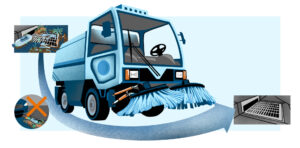Street sweeping is the unsung hero in the war that local governments wage against the impacts of intense storms on our urban areas. As cities face increasingly frequent and severe storms and stricter water quality regulations, they must adjust their tactics to control rainwater flow, prevent local flooding, and reduce pollutant loading into waterways. An effective street sweeping program keeps streets clean, reduces the likelihood of local flooding, and protects waterways from harmful pollution. Street sweeping is one of the least costly and most effective stormwater best management practices.
>> Download Our Free Street Sweeping Guide <<
An Effective Stormwater Best Management Practice
Street sweeping is a simple, effective, and affordable way to remove trash, leaf litter, and toxic pollutants from urban streets and parking lots. The modern street sweeper uses brushes and vacuum suction to clean paved surfaces. If not removed before a rainstorm, that debris will clog stormwater catch basins and inlets, which are essential for moving rainwater and preventing flooding. Street sweeping also collects harmful pollutants, such as microplastics, metals, and toxins, preventing them from contaminating waterways in ways that harm aquatic life and pose risks to humans and wildlife. Studies, such as Sutherland and Jelen’s (1997), suggest that up to 80 percent reductions in annual TSS and associated pollutants could be achieved using bimonthly to weekly sweepings.

Protects and Prolongs the Life of Infrastructure
As cities invest in more green infrastructure and nature-based solutions to mitigate the impacts of urbanization, this stormwater best management practice significantly reduces the maintenance needs of these assets to ensure they continue providing the intended environmental benefits. Since street sweeping removes pollutants before they even enter the storm drain system, cleaning and maintaining structural controls costs are decreased. Removing particulate matter can reduce sediment to downstream treatment controls, extending the life of these practices and improving water quality further downstream. Street sweeping can be up to 90% effective for removing pollutant-laden sediments from roads, translating to over a 50% reduction in stormwater pollution discharged by a city annually.
Rallying Support of Citizens
To ensure success, stormwater managers must communicate the value of street sweeping programs to gain their community’s support. To make sweeping efforts effective, operators must access the curb where most of the debris and trash accumulate. Beautification, local pride, better water quality, and reduced flooding benefit car owners, who can help ensure sweepers get to the curb. This means reaching out to educate and build awareness within the community and collaborating with residents to optimize sweeping routes and schedules and implement manageable parking restrictions.
Stormwater Management Software
Stormwater management software, like 2NFORM, can help cities plan more effective street sweeping efforts through data collection, real-time monitoring, predictive analytics, and resource allocation. By collecting data on various factors that affect street sweeping and providing real-time information on progress, cities can optimize street sweeping schedules and routes. Software like 2NFORM provides predictive analytics that forecast the amount of debris accumulating in different city areas, helping them plan more efficient and effective street sweeping schedules. Finally, stormwater management software can help cities allocate their efforts and equipment more effectively by identifying areas that require more frequent street sweeping and areas that can be swept less frequently, ultimately leading to cleaner and safer streets.
Conclusion:
Effective street sweeping is an essential aspect of strategic stormwater management that plays a crucial role in controlling the flow of rainwater, preventing local flooding, and reducing pollutant loading into waterways. Street sweeping removes pollutants before they enter the storm drain system and clog catch basins and inlets, extending the life of green infrastructure and nature-based solutions and reducing maintenance costs. By communicating the value of street sweeping programs and collaborating with residents, stormwater managers can optimize sweeping routes and schedules and implement parking restrictions that benefit the community. As a result, street sweeping provides a simple, effective, and affordable solution to mitigate the impacts of urbanization on local water quality and prevent local flooding. So, the next time you see a street sweeper on your block, take a moment to appreciate this unsung hero in the battle against stormwater flooding and pollution.




